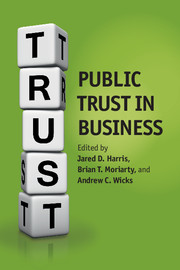Book contents
- Frontmatter
- Contents
- List of figures
- List of tables
- Notes on contributors
- Preface: discovering new territory in public trust in business
- Acknowledgments
- 1 Public trust in business: what’s the problem and why does it matter?
- Part I Trusting the institution of business
- 2 The economic crisis of 2008, trust in government, and generalized trust
- 3 Too big to trust? Managing stakeholder trust in business in the post-bail-out economy
- 4 At the crossroads of trust and distrust: skepticism and ambivalence toward business
- 5 Public trust in business and its determinants
- 6 The role of public, relational, and organizational trust in economic affairs
- Part II Public trust and business organizations
- Index
- References
5 - Public trust in business and its determinants
Published online by Cambridge University Press: 05 July 2014
- Frontmatter
- Contents
- List of figures
- List of tables
- Notes on contributors
- Preface: discovering new territory in public trust in business
- Acknowledgments
- 1 Public trust in business: what’s the problem and why does it matter?
- Part I Trusting the institution of business
- 2 The economic crisis of 2008, trust in government, and generalized trust
- 3 Too big to trust? Managing stakeholder trust in business in the post-bail-out economy
- 4 At the crossroads of trust and distrust: skepticism and ambivalence toward business
- 5 Public trust in business and its determinants
- 6 The role of public, relational, and organizational trust in economic affairs
- Part II Public trust and business organizations
- Index
- References
Summary
Executive summary
The situation
As the importance of public trust in business becomes ever more obvious to both practitioners and scholars, the levels of generalized trust in business have reached alarmingly low levels.
Key questions
Is an emerging trust gap – where the need for trust outpaces the actualization of trust in business – likely to impair successful business development? What are the determinants of public trust in the institution of business? Do stakeholder-role-specific perspectives impact public trust in business? If so, how do they do so?
New knowledge
Men tend to be more trusting of business than are women. Age plays a role in people’s trust in business, with those 23 years old or younger being much more likely to trust business.
While it is commonly supposed that the public has greater trust in smaller companies, this study finds that changing the size of the firm from small, regional, national, or global does not substantially “move the dial” for trust. The authors’ research, however, does find that public trust in business will be affected by a firm’s industry.
Key lessons
Public trust in the institution of business matters to all companies, since it colors stakeholder trust in particular businesses.
Age and gender play a role in stakeholder trust. Business leaders should be cognizant of these differences when assessing the status of their relationships with various stakeholders.
- Type
- Chapter
- Information
- Public Trust in Business , pp. 116 - 153Publisher: Cambridge University PressPrint publication year: 2014
References
- 7
- Cited by

